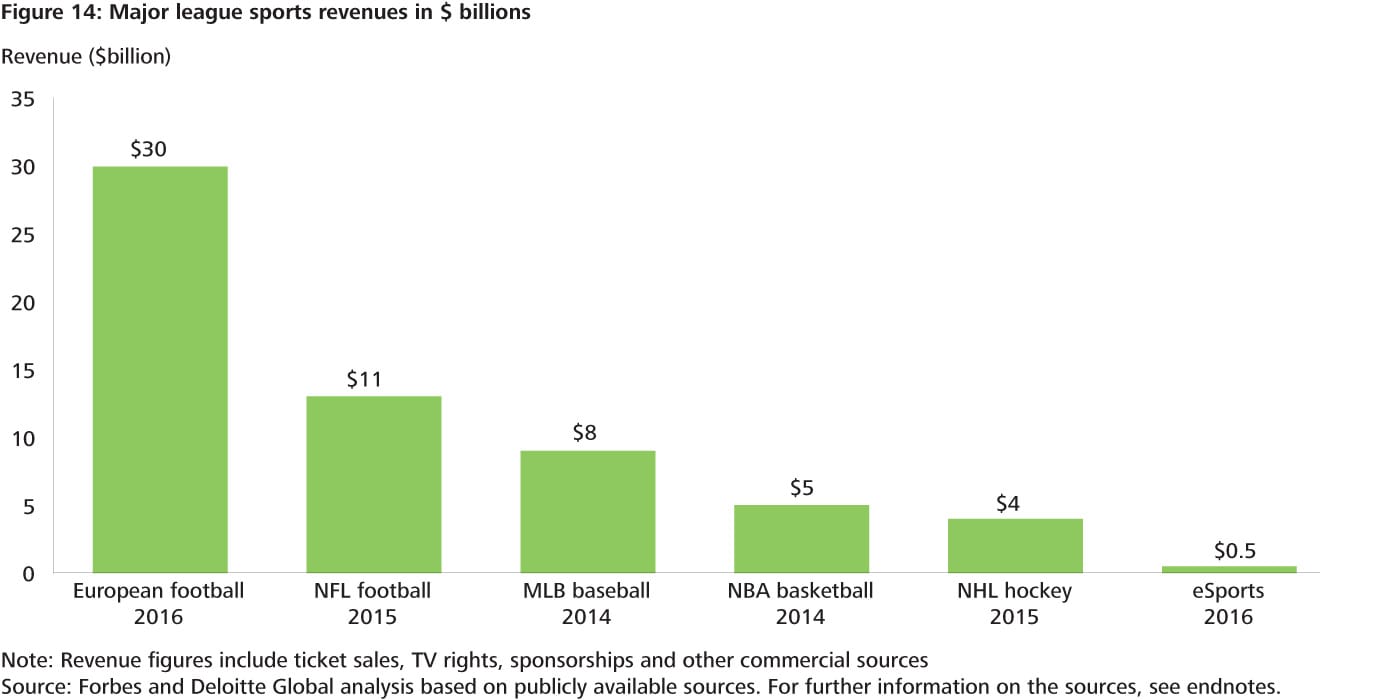Predictions

eSports: bigger and smaller than you think
TMT Predictions 2016
eSports: Bigger and smaller than you think
Deloitte Global predicts that eSports will generate global revenues of $500 million in 2016, up 25 percent from about $400 million in 2015, and will likely have an audience of regular and occasional viewers of close to 150 million people.
The very idea that people may be willing to watch other people play competitive video games for big money prizes may surprise some. These skeptics often under-estimate the global annual market size as being in the millions of dollars only. Conversely, eSports advocates overestimate the current market size, believing annual revenues are already in the billions, and comparable to major league sports.
Today, a major eSports event may attract 40,000 people watching live, and tens of millions watching over the Web. This could be interpreted as meaning that “eSports is bigger than basketball”. That may be true when measured by audience size for an individual event. However, there are far fewer major events for eSports than for traditional sports, which means that in dollar terms eSports is not yet playing in the big leagues (Figure 1).

Source: Forbes and Deloitte analysis based on publicly available sources (tickets, TV rights, sponsorships and other commercial sources)
Revenues for e-Sports are predicted to grow 25 percent in 2016, which is better than most mature sports, but not especially impressive for a new entertainment market. However, some believe eSports is approaching an upward inflection point: one American analyst predicts that eSports in the US alone will leap from $85 million in 2014 to $1.2 billion in 2018: a 94 percent compounded growth rate, which is triple the projected 2016 growth over 2015.
Deloitte does not believe the annual growth rate of eSports revenues is about to triple, but even if it does it will still only represent one percent of global sports revenues. That being said, eSports does reach tens of millions of people on a regular basis, and over a hundred million occasionally – making it comparable to some traditional sports.
Tech and media companies are paying attention to eSports, for both growth opportunities and because it appeals to a narrow and desirable demographic: 75 percent are millennials aged 18-34, and 82 percent are men. Amazon acquired Twitch for just under $1 billion in 2014, while 2015 saw Swedish media company Modern Times acquire a majority stake in ESL, the oldest eSports company for $87 million. Russian investors have committed $100 million. Canadian motion picture exhibitor Cineplex is spending $15 million to acquire an eSports company and create a new gaming league that will take place in its theatres, and the first dedicated eSports venue has been opened in the UK in partnership with a cinema chain. Although e-Sports might not match or surpass traditional sports any time soon, its potential business value is clearly too significant to ignore.
1 For a complete list of references and footnotes, please download the full PDF version of the TMT Predictions 2016 report.
Deloitte Global predicts that eSports will generate global revenues of $500 million in 2016, up 25 percent from about $400 million in 2015, and will likely have an audience of regular and occasional viewers of close to 150 million people.
The very idea that people may be willing to watch other people play competitive video games for big money prizes may surprise some. These people often under-estimate the global annual market size as being in the millions of dollars only. Conversely, eSports advocates overestimate the current market size, believing annual revenues are already in the billions, and comparable to major league sports.
In some ways, eSports is comparable. A single event (but not that many per year) may attract 40,000 people watching live, and tens of millions watching over the Web. This could be interpreted as meaning that “eSports is bigger than basketball”. That may be true, when measured by audience size for an individual event, but in dollar terms, eSports is not yet playing in the big leagues.
In 2016, eSports revenues will represent a fraction of league revenues in major sports such as European football (soccer), US football, basketball, baseball, or ice hockey which range from $4 billion up to $30 billion (see Figure 1).

Note: Revenue figures include ticket sales, TV rights, sponsorships and other commercial sources
Source: Forbes and Deloitte Global analysis based on publicly available sources. For further information on the source, see end notes.
Revenues for e-Sports are predicted to grow 25 percent in 2016, which is better than most mature sports, many of which have been around for a century or even centuries. Arguably, given its small size, some might ask why eSports’ growth rate is not higher.
Some believe that eSports is approaching a tipping point or upward inflection in the market: one American analyst predicts that eSports in the US alone will leap from $85 million in 2014 to $1.2 billion in 2018 : a 94 percent compounded growth rate, which is triple the projected 2016 growth over 2015.
Some are linking the popularity of online video game-related content to eSports. The top gaming-related video star is PewDiePie, with 40 million subscribers, and number two is VanossGaming, with 15 million subscribers. They may be the biggest stars, but collectively gaming videos make up more than 10 percent of YouTube’s top performing channels.
However, Deloitte Global does not believe that there is a direct correlation between online video gaming success and eSports and, therefore, that the annual growth rate of eSports revenues is not about to triple. The most popular online content is not about watching elite gamers competing. Instead, the content is about entertainment (both PewDiePie and Vanoss are better known for their humor than being top-ranked players) or is largely instructional in nature: teaching gamers how to find hidden treasures (Easter eggs) or surmount difficult in-game challenges.
There is nothing wrong with educating or entertaining tens of millions of gamers (usually for free, except for the ads), but it also may not directly lead to tens of millions willing to either subscribe or pay to attend an eSports tournament. So far, much of the online gaming audience is more comparable to fans of the Harlem Globetrotters (people who are entertainers, who happen to play basketball) rather than to fans of a successful pro basketball team who plays to win a championship.
Tech and media companies are paying attention to eSports, for both growth opportunities and because it appeals to a narrow and desirable demographic: 75 percent are millennials aged 18-34, and 82 percent are men. Amazon acquired Twitch for just under $1 billion in 2014, while 2015 saw Swedish media company Modern Times acquire a majority stake in ESL, the oldest eSports company for $87 million. Russian investors have committed $100 million. Canadian motion picture exhibitor Cineplex is spending $15 million to acquire an eSports company and create a new gaming league that will take place in its theatres, and the first dedicated eSports venue has been opened in the UK in partnership with a cinema chain.
Bottom Line
Even if eSports’ revenues were to triple between 2016 and 2020 (to $1.5 billion), they would only be one percent of global sports revenues of over $150 billion. But eSports does reach tens of millions of people on a regular basis, and over a hundred million occasionally. As such, it is comparable to many traditional sports that have large audiences, big sponsors and interesting demographics. One study predicts that eSports will have more viewers than NFL football by 2020. One report describes them as “an advertising goldmine”, which is supported by their spending habits: eSports fans are more likely to make in-game purchases, buy more apparel and buy more branded peripherals than other gamers.
The assumption tends to be that eSports fans are dominated by those who prefer gaming on their computers. In fact, only 35 percent of US eSports fans were PC gamers, with nearly 80 percent of fans being console gamers. Mobile games have not been a part of eSports, although that is beginning to change.
Immersive technology like VR goggles may make eSports even more interesting. However, this is unlikely to be an important growth area for eSports in the near term: our 2016 Prediction on the VR market expects combined hardware and software sales of less than $1 billion (see Prediction: Virtual reality: A billion dollar niche).

@DeloitteTMT